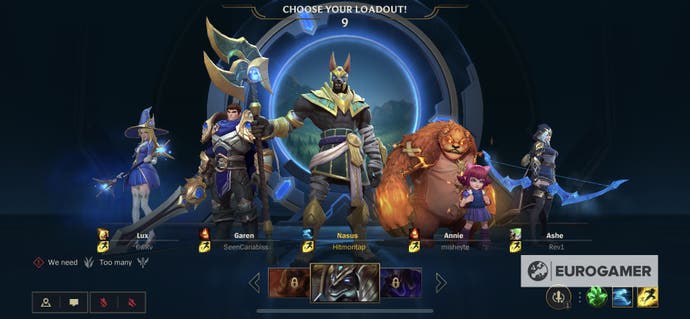League of Legends: Wild Rift is everything a LoL player could want, barring a little player-made magic
MOBAile.
We talk a lot about how well, or not-so-well designed a game is, but it's not often you get to talk about how much design there is in one, the sheer volume there is of it. League of Legends, which I've been playing again recently after an extended break (if anyone wants to stage an intervention, honestly please do), might have the most design-per-square-inch of game out of any. Systems on systems on systems, just the game's launcher is a game in itself: progression within progression, crafting keys to craft chests, unlocking skin shards to unlock skins, building out skill-tree-like rune pages to complement your in-game, skill-tree-like build of items. On and on, the forever game in motion.
Exhausting - but I love it for its exhaustiveness, its galactic breadth, width and depth, and that only makes League of Legends: Wild Rift even more of a surprise. Wild Rift is mobile-only for now - still in open beta and still in only a few places (playable here in Europe, but crucially not yet in North America or China) - and coming to consoles somewhere down the line, and it's very good. Dense and a little awkward but good, because it is, like League on PC, exhaustive.
The basics for those completely unfamiliar are that it's more or less exactly the same MOBA as League of Legends in all the key ways - but also different in every way, too. The core is identical: it is absolutely League of Legends, not Heroes of the Storm, not Dota 2, not Smite, and not any of the many mobile spin- (or rip-) offs that they've spawned over the years. Fundamentally, of course, the difference is in the controls. Wild Rift is a conversion of a game that is arguably the most demanding of precise mechanical inputs, from the most mechanically precise format of mouse and keyboard, to the most mechanically imprecise format of a phone. Everything in the game then is a question of how you adapt for that total difference while keeping the actual game the same, and the solutions are often ingenious.
How do you keep last-hitting, for instance - the exacting practise of ensuring that you land the killing blow on an enemy minion, amid a cluster of other minions and enemy hazards, right when it has a slither of health left - when you can hardly pick a minion out with just the fat end of your thumb? Well, you give minions a sort of stay of execution, where they seem to survive a little longer while on last-hittably-low health, and you have about three different ways of aiming at things, including a priority targeting button that puts your champion into a kind of semi-autopilot farming mode while you're at it.

These micro-dilemmas are everywhere, in every occurrence of every miniscule piece of League's infinite complexity, and at every turn they're solved with remarkable ingenuity. Games are shorter, averaging 10-20 minutes, instead of 30-50. The map, I think, is smaller, or maybe you move faster, or maybe the items give you more movement speed. The map is also reversed, sometimes, solving a problem I hadn't even thought of. You fight from bottom-left to top-right or top-right to bottom-left, on PC, the way it's always been and always will be, but on mobile that wouldn't work because you use the bottom two corners of the screen for touch-controls - and so, if you were on the team moving from top-right down to bottom-left, you wouldn't be able to see where you were going because of your own cumbersome hands, putting you at a big disadvantage. Wild Rift fixes this by rotating the map, mind-bogglingly, so you're always fighting bottom-left to top-right.
This is where things get slightly awkward though, and where the whole premise of Wild Rift itself does seem to wobble. In League of Legends you generally have champions that generally suit set roles, which generally suit set positions on the map. It's normally 1v1 in the top lane, 1v1 in the mid lane, 1v1 in the jungle, and 2v2 in the 'bot' lane along the bottom. Certain champions suit those types of matchups (tankier ones top, mobile ones in the jungle, bursty ones in mid, and late-game carries and their supports in the bottom), and the effect now, especially in the years since Riot introduced a 'team builder' stage to joining a game, where you all lock-in your preferred role before you're even matchmade with others, has been to sort of solidify those champion-role-position combinations as not just a prevailing 'meta', but a kind of 'canon': Blitzcrank is a support, played alongside carries in bot-lane; Garen is a tanky bruiser, played top. You can play them elsewhere technically but generally, you don't.

So, come to Wild Rift, and say you pick a typically bot-lane carry, and your teammate knows the game well enough to pick a complementary support, but then you enter a match and the support runs to the bottom lane, as does... a top-laner? So you go to the top lane but there's also a top-laner there? And nobody picked a jungler? Bot lane is now 'Dragon Lane', you see, because for one team of course the map has rotated, and so the carry-and-support duo are supposed to go to whichever lane is nearest to the Dragon, bot or top. But that's not as clear as just 'go bot' or 'go top' and traditions like calling a champion a 'toplaner' themselves then go out the window too. In other words, a little nudge like this and it can suddenly fall apart. There are in-game prompts and pre-game 'we need a support' prompts and repeated pop-ups to remind you that you're on the mirrored side, of course, but people, at least so far, don't really get the memo. Couple that with the jumbled mix of seasoned League players and Wild Rift newcomers, and it's all a bit of a mess.

For the moment, this is where things come a little unstuck - although I should emphasise it really is just for the moment, as things are very early in Wild Rift's lifetime and the audience likely quite different to the final one. So far, the lesson of Wild Rift is that you can rework all the quite astronomical number of individual elements to League in order to make it work on mobile, and barring some input clumsiness on the user's part that'll generally work. But moving the game over is different. As well as being an unparalleled, clockwork marvel of design, League of Legends is also a marvel of team play. It's built on unspoken rules, cooperation understood across the length of a match, coordination relied on down to the specific spots you stand at specific millisecond moments. This is why it's so incomprehensible to watch and understand, but also so intoxicating to play once you do. To play it is to be one of many, never-less-than-essential cogs, in a larger, miraculous machine. For now, that kind of psychic understanding is missing, and without it you're left without the spirit and just the machine.
All of the design is there in Wild Rift, and it's genuinely astounding, packaged within a level of truly slick presentation I've never seen before on mobile, too. I suspect it'll get there with time, because the tools are all there for coordination, all very cleverly tweaked and reworked and repositioned, but it just hasn't quite congealed yet. It's missing the human touch, in other words. The people. The ones that take all that design and make it into a game.










